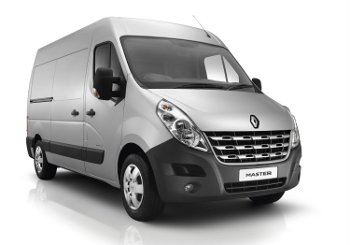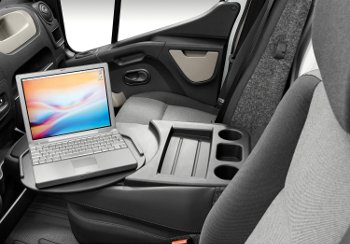The New Renault Master – Good Motorhome Material?

The new Renault Master van will be launched in the UK on April 9th. Renault has just published the specifications and price lists for its new van – so naturally, I had a look to see how it shapes up from a motorhome base vehicle perspective.
FWD, RWD, 4 Lengths & Up To 4.5 Tonnes!
The new Master will eventually be available in no fewer than 350 versions, including both panel van, chassis cab, crew cab and minibus variants.
The panel van will be available in 4 lengths, two roof heights and in both front and rear-wheel drive, with gross weights from 2.8 tonnes to 4.5 tonnes. Rear-wheel drive models have twin rear wheels and a differential lock is available as an option – ideal for poor surfaces.
The dimensions are very similar to those of the Mercedes Sprinter and Ford Transit range – the longest model is just under 7m and boasts an impressive 4.3m internal load length. The internal width is 1765mm – similar to the Sprinter and Transit but 10.5cm less than the Fiat Ducato. This extra width is one of the reasons the Ducato is by far the most commonly-used van for panel van conversions – it makes transverse beds more of a realistic proposition and gives more layout options than narrower vans.
All models of the new Master will use the same 2.3 litre dCi diesel engine, which comes in three versions – 100, 125 and 150hp. Although one engine for all models seems restrictive, in practice, there should be an engine option that’s suitable for everyone, I think.
Inside The Cab
As you might expect from a new model, the cab of the new Renault Master is well specified and aimed at the needs of working van drivers.

This means lots of creature comforts, including built-in sat nav and air con on many models, as well as clever storage and office features – including storage for large items below the twin passenger seat and a clever arrangement where the centre passenger seat folds forward to become a desk-cum-drink holder – ideal for motorhome use if you can live without a swivel passenger seat.

Will Motorhome Converters Switch To The New Master?
When I saw switch, I mean switch from the Fiat Ducato chassis cab. The answer, of course, is no. Fiat has tailored its offering to the motorhome converter market and offers the widest and (I think) lowest chassis cab platform for motorhome converters building coachbuilt motorhomes – the majority of the motorhome market. The Ducato panel van is still the widest on the market, too, offering the layout advantages I mentioned earlier.
Cost, too, is an issue. Ducatos are reputed to be far cheaper (at trade prices) than anything else on the market. Even at current UK list prices, Ducato panel van prices start from £17,415 +VAT while launch prices for the new Master will start from £20,795 – quite a big difference.
Finally, Fiat’s Camper Assist service provides breakdown cover across most of Europe, tailored to the needs of motorhomes. No other manufacturer has a service like this that can easily be packaged with every Fiat-based motorhome.
However, there are always a minority of models built onto different base vehicles and the Renault Master has always had a share of this section of the market, along with the Transit and the Sprinter. I can certainly see a niche for the new Master as a platform for large, 4-6 berth family coachbuilts. A 4.5 tonne, rear-wheel drive chassis cab ought to allow for greater payloads, better weight distribution and better driving characteristics than a front-wheel drive 4-tonne Ducato, rather as the 5-tonne Sprinter does at present.
Will It Fall Apart?
Despite the slightly flakey reputation of Renault cars, previous generations of the Renault Master have enjoyed fairly decent reputations for build quality and reliability. It will be interesting to see how this model fares – and how it drives, compared to others on the market.
Would I Buy One For My Next Motorhome Conversion?
It’s too early to say what kind of reputation this van will gain for itself, but at first glance, if I was planning another panel van conversion, then my base vehicle shortlist would probably include the new Master. I really like the idea of a rear-wheel drive van with diff lock as a compromise between a front-wheel drive van and a 4×4 van. The extra traction and stability of this setup could be an asset for unsurfaced roads, snow and ice and muddy campsites (especally if combined with winter tyres). I don’t think Ford or Mercedes offer a locking diff, although both offer four-wheel drive versions of their vans.

Does anybody convert luton bodied vehicle? if so why so? If not why not? please any info for novice.X
Hi Roger,
The problem with commercial luton bodies designed for goods use is that they are not really constructed in the same way as purpose-built motorhome bodies. For example, the luton area over the cab in a commercial body is not built on to the cab roof – it just hangs above it and cannot be used for any serious weight. In contrast, a motorhome luton is built onto the roof of the cab and can be used as a double bed. Similarly, the cab is not connected to the body, so constructing walk-through access from the cab to the motorhome body is awkward and difficult to do nicely.
Commercial lutons also have no rear wall — they usually have roller shutters or perhaps barn doors, both of which would need to be replaced with a new panel and an habitation door. Although it could be done (and is sometimes, by DIYers), converting a commercial luton body to a decent motorhome is quite a lot of hassle and perhaps not really worth it, especially as not being able to use the luton as a bed reduces interior space quite a bit.
Cheers, Roland